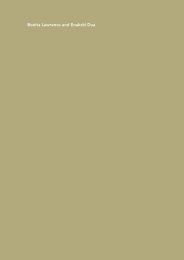John Ralston Saul - Speaking My Truth
John Ralston Saul - Speaking My Truth
John Ralston Saul - Speaking My Truth
You also want an ePaper? Increase the reach of your titles
YUMPU automatically turns print PDFs into web optimized ePapers that Google loves.
<strong>John</strong> <strong>Ralston</strong> <strong>Saul</strong>Response, From Responsibility, <strong>Truth</strong> to Reconciliation and Renewal | 279 | 279
<strong>John</strong> <strong>Ralston</strong> <strong>Saul</strong> was born in Ottawa, Ontario. He studied at McGill University andat University of London, where he obtained his doctorate in 1972. A Companion inthe Order of Canada (1999), he is also Chevalier (knight) in the Ordre des Arts etdes Lettres (Order of Arts and Letters) of France (1996). His 14 honorary degreeshave been given to him by McGill University, University of Ottawa, and Herzen StatePedagogical University in St. Petersburg, Russia, among others.<strong>John</strong> is an award-winning essayist and novelist who has been having a growingimpact on political and economic thought in many countries. <strong>John</strong> believes thatCanada is influenced and shaped by Aboriginal ideas: egalitarianism, a properbalance between individual and group, and a penchant for negotiation over violenceare all Aboriginal values that Canada has absorbed. Among many issues that he isparticularly known for his commentaries, of note are his discussions on the nature ofindividualism, citizenship, and the public good and the role of freedom of speechand culture. <strong>John</strong> is presently Series Editor of Penguin’s “Extraordinary Canadians”project. He is also the co-chair of the Institute for Canadian Citizenship, patron andformer president of PEN Canada, founder and honorary chair of French for the Future,chair of the advisory board for the LaFontaine-Baldwin lecture series, honorary chairof the Project Advisors’ Committee for Evergreen at the Brickworks, and patron of theCanadian Academy of Independent Scholars, PLAN (a cutting edge organization tiedto people with disabilities), Engineers without Borders, and the Canadian LandmineFoundation.As a writer or editor, <strong>John</strong> has had many works published, both fiction and non-fiction.His latest works include A Fair Country: Telling <strong>Truth</strong>s about Canada (2008) and TheCollapse of Globalism and the Reinvention of the World (2005). His works have beentranslated into more than a dozen languages. <strong>John</strong> has received many national andinternational awards for his writing, most recently the Pablo Neruda InternationalPresidential Medal of Honour from the Chilean government. He also received theGovernor General’s Literary Award for non-fiction, two Gordon Montador awards,and a Premio Lettarario Internazionale in Italy.
Reconciliation: Four Barriers to Paradigm ShiftingReconciliation can only begin when the people of Canada collectively wishit. This proposed desire to live differently with the other has to be preciselythat—a desire. Travelling about the country over the years and, in particular,over the last two months after publishing A Fair Country, 1 I have sensed thatpeople are now ready for reconciliation. I sense this particularly from theeagerness with which many Canadians have embraced the idea that Canadais a country inspired more by Aboriginal world views than European worldviews. Many Aboriginal leaders have been saying this in one way or anotherfor many years, but it has been as if non-Aboriginal people were not listening,did not know how to listen, or were intimidated by the message. Now, manyare no longer intimidated by this way of thinking. How many? I sense thatthis is building into a new consensus; yet, a consensus can be nothing morethan romanticism if people do not work out why they now feel this way andwhat went so wrong that it obscured our shared reality for a century and ahalf. I can think of four things that still stand in the way. Four barriers willhave to be dealt with, and some of Canada’s institutions will have to undergoparadigm shifts if any real reconciliation is to take place.Barrier One: Lacking a Plan for ChangeFirst, while non-Aboriginal people may now be ready for change, many ofthem still have no idea of how to go about it. This is no longer the result ofill will. They simply have little sense of what that change would look likerealistically. Those who have been explaining the situation and layingout scenarios for decades—those involved with the Royal Commissionon Aboriginal Peoples, for example—must be amazed at how little of thisdebate has made its way into the public consciousness. Each breakthrough,which ought to have been initiated immediately, has broad implications forhow our society could function. Supreme Court decisions such as Guerinand Delgamuukw, 2 for example, or the Haida and Taku decisions 3 on theobligations to consult have been immediately shrunk into the narrowestpossible definitions. These breakthroughs are still treated as if they areexceptions to the rules of Canadian society, which they are not.Canadians in general now seem to be ready to assume guilt or responsibilityfor wrongs done when it comes to questions on Aboriginal issues. But guiltand responsibility are only preliminary steps. They may clear the way forchange, but they do not represent change itself. If left on their own, they canResponse, Responsibility, and Renewal | 281
was no reality here, as if everything important begins elsewhere. While it isgood to have specializations and therefore good to concentrate on Aboriginallaw or literature, this should not mean that Aboriginal world views aresidelined as a closed-shop specialty. These ideas also need to be built intothe heart of how we all think about philosophy, politics, and literature. Thatis how you construct the language of understanding and reconciliation. Tobe precise, if the Aboriginal concept of the circle is the basis of the Canadianapproach towards citizenship, immigration, and federalism, we make aterrible mistake in acting as if the sources for these things were mysteriouslyfound in the Enlightenment, in the Westphalian nation-state model, or inearly European democracy.There are three obvious examples of how faulty this approach can be, and theylie in 1) the status of Delgamuukw, 2) the treatment of Aboriginal languages,and 3) the federal government’s approach to Northern sovereignty.Delgamuukw represented an important breakthrough in the formalindigenization of Canadian law, not simply in the treatment of indigenousoral memory. Of course, the legal recognition of oral memory was arevolution in the interpretation of this case and of other related cases.But Canada is, in general, a far more oral culture than any other Westerndemocracy. This orality is constantly being enriched by the strengtheningof Aboriginal society and its role in Canada and by the continuing arrival ofimmigrants—soon to be citizens—whose first language is neither Englishnor French. For the whole life of these new first-generation citizens, theirrelationship with Canada will be primarily oral. If this works in a waythat is not so easily done in other countries, it is because there is a stronginheritance of Aboriginal orality, very much alive and powerful, uponwhich new Canadians can build. This Aboriginal-immigrant relationshipshould be one of the most important relationships in Canadian society. Yetthe mainstream structures seem to stand in the way of what could be thesingle most important conversation inside our society—between Aboriginalpeople and new Canadians. This is a missing conversation central to anyreal reconciliation. Few efforts are being made to encourage it, yet there isno history of antagonism or betrayal between Aboriginal people and newCanadians. Without slipping into generalizations, many of the latter aresimply confused by a debate from which they feel excluded.The precise comment that can be made on Delgamuukw is that it couldbe used as a broad principle throughout governmental legal debates withAboriginal people and throughout Canadian law in general. Delgamuukwrepresents a partial normalization of the indigenous roots of Canadian law.Perhaps this reality is being ignored by most of the legal community becauseResponse, Responsibility, and Renewal | 285
it threatens their Euro-US-derived state of mind. But that is their problem.It should not be ours. The concept of orality in Canadian civilization, withits inspiration and roots derived from Aboriginal world views, couldbe a valuable tool in altering the nature of our shared conversations, inindigenizing them and, therefore, in opening another path to a deeper sort ofreconciliation. English and French aside, there are more than fifty survivinglanguages indigenous to this place. Each of them belongs to a particularpeople that are also part of the complex Canadian texture. The large majorityof these languages are in danger of extinction. 7 That is a tragedy for theirparticular nation, but it is also a tragic loss for all Aboriginal and non-Aboriginal people in Canada. A language lost represents the closing of a dooron our ability to understand ourselves in this place. Not to understand thisis to reveal a deep dependence on the colonial model of imported culturesas the root of Canadian civilization. How can we talk of reconciliation whenthe Government of Canada is still dragging its feet to support the teachingof these languages? They are an essential part of the shared collectiveunconscious.The current anxiety over Canadian sovereignty in the Arctic echoesthe colonial mindset. Our claims are based on a legal thread leadingfrom unsuccessful British explorers—trying to get through the Arcticto somewhere else—to British ownership, and from there to Canadianownership. You would have thought that a simpler and far stronger legalargument would have been that Canadians have been living in the Arcticfor thousands of years. They are Inuit. We are attempting to make ourshaky British-derived claim through the Law of the Sea arguments, butthis law is based on a European legal idea of water—a few hundred yearsold—as something that separates land and is susceptible to penetrationby enemies. The Inuit-based idea—thousands of years old—is that waterand ice join land, and it is this idea that constitutes the principal means ofcommunication for Inuit. We would do far better to advance this concept.That would mean describing Canada as a country indigenous to this place,and that would mean the development of a language of reconciliation.What I am arguing here is that a mass of Aboriginal words and concepts existsthat presents the world and our existence in a very different way than that ofstandard European concepts. There is an urgent need to bring those words andconcepts into a broad public place. If we do so and talk among ourselves abouttheir full meaning, I believe that we will discover both the roots of our sharedcivilizations and the fundamental language of reconciliation.286 | <strong>John</strong> <strong>Ralston</strong> <strong>Saul</strong>
Barrier Four: Absence of Shared Public MechanismsThe fourth barrier to this reconciliation is the absence of the practical,shared public mechanisms from which we can all work. Some of theseare painfully obvious. As long as the treaty and other related negotiationsare dragged out, it will remain impossible for everyone to move towardsa constructive relationship. As long as most non-Aboriginal people inCanada do not understand the role and implications of the treaties, let aloneunderstand that they too are treaty people, the negotiations will drag onin a modern facsimile of the old ways. The life of endless legal details doesnothing for anyone except for those who are paid to drag out the process.Meanwhile, the lives of Aboriginal leaders are marginalized by their need toconcentrate on treaty battles rather than on broader social construction andreconciliation. For years now, good people have tried to get this message ofwaste across to the population at large. Banal though it is to say, but as longas treaty-related negotiations are not finished, reconciliation will not happen.The mechanisms of delay, being as deeply anchored as they are in ourgovernmental and legal systems, means that only pressure from the broadpopulation can speed up government action.Paradigm ShiftingOf course, the process of treaty negotiations will continue, yet I cannot helpbut think that a very precise strategy is needed to change education acrossthe country. Some provinces have already begun building the Aboriginalpillar into their teaching of history to classes that are largely non-Aboriginal.The challenges are only partly about history and geography, they are alsoabout ideas central to the way in which we all imagine ourselves. Our civicscourses need to build ideas from Indigenous world views into the primaryexplanations of our democracy. Our literature courses, still structured as ifwe were colonial outcroppings of Britain and France, need to be radicallychanged. Philosophy and ethics are taught in our high schools as if Canadadid not exist, let alone the Aboriginal civilizations that shaped Canada.In other words, there is an urgent need to go to the provincial ministersof education in order to propose how curricula could be changed. Equally,there is a need to attack our university systems in a highly strategic way.Environmental studies need to be attacked for their artificially value-freeapproach and their avoidance of an Aboriginal concept of humanity’sintegrated place in the process. Philosophy departments have to be pushedto change their narrow and derivative European approach. Our wholeconcept of Northern studies illustrates the basic problem. We are the onlycircumpolar country without a university in the Arctic. We have threecolleges. The southern universities have a monopoly on Northern studies.Response, Responsibility, and Renewal | 287
Their professors and students come up in the summer to study and observe.They head back home for winter in the South. There is no buildup of wealthof Northern studies in the North, let alone investment in the communities. Athree-campus Northern university with four research chairs at each wouldradically change the way everyone thinks about the Arctic, the Inuit, andthe northern environment. There would be a long-term opportunity for Inuitand other Aboriginal and non-Aboriginal professors to develop real northernstudy centres in the North, attracting young Inuit and other Canadians.At the heart of all that I am describing lies the gradual slippage of Canadiansmoving away from the idea that citizens—Aboriginal or not—can be partof modernity if they live in smaller isolated communities. The truth is thatCanada cannot exist if we think of it as merely a southern, urban reality. Whatthen becomes of the physical country and the necessary balance betweenplace and people? Over half of the 1.2 million Aboriginal people in Canadalive at least part of the year in cities, 8 but Canada only makes sense as acountry if its whole physical reality works. This means seeing the non-urbancountry—that is, most of our non-Westphalian nation-state—as a positiveforce that must be strengthened. That means treating the non-urban countrynot as a costly appendage and realizing that these hundreds of communitiesneed to be seen as filled with purpose—another sort of purpose—whichmakes the whole country make sense. The idea of Canada as a place tiedto a deeply non-urban and non-rural civilization is key to understandingourselves and therefore understanding what reconciliation might feel like.All of this is part of the idea that people can only discover and livereconciliation if they understand what it would look like and feel like. It meansto think of themselves in a different way—a way that is not European derived.If non-Aboriginal people in Canada begin to see themselves as being fromhere in the sense that they are inspired by ideas proper to this place and to thepeoples of this place, then reconciliation will make sense to them.288 | <strong>John</strong> <strong>Ralston</strong> <strong>Saul</strong>
Notes1<strong>Saul</strong>, <strong>John</strong> <strong>Ralston</strong> (2008). A Fair Country: Telling <strong>Truth</strong>s about Canada. Toronto, ON:Viking Canada.2The Delgamuukw v. British Columbia court case was launched by the Gitxsan andWet’suwet’en peoples and was intended to reclaim their land through acknowledgementof ownership, jurisdiction, and self-government of their traditional territories by theprovincial and federal governments. The decision of the Supreme Court of Canada,handed down on 11 December 1997, did not settle the original claim, but it did confirmthe existence of Aboriginal title in British Columbia and has since had far-reachingeffects on policies, positions, mandates, and laws that impact on First Nations, especiallywith the treaty negotiations process. The decision also ensured that, in future trials, oralevidence would be granted as much weight as written evidence. In Guerin v. The Queen,Musqueam First Nation sued the federal government for breach of trust in the leasefor the Shaughnessy Heights Golf Course in south Vancouver, which was entered intoby the federal government on behalf of Musqueam First Nation. When disclosed, theactual terms of the lease were much less favourable than the terms discussed with theDepartment of Indian Affairs when the First Nation agreed to surrender the land. Thedecision of the Supreme Court, handed down in 1984, recognized the Crown’s fiduciaryrelationship with First Nations. It established that the Crown would be held to a rigorousstandard of loyalty toward First Nations when dealing with First Nations’ interests inland. Ten million dollars in damages were awarded in favour of Musqueam First Nation.Delgamuukw v. British Columbia [1997] 3 S.C.R. 1010; and Guerin v. The Queen [1984] 2S.C.R. 335.3Haida Nation v. British Columbia (Minister of Forests), 2004 SCC 73; and Taku River TlingitFirst Nation v. British Columbia (Project Assessment Director), 2004 SCC 74. For a goodreview of these decisions, see: Olynyk, <strong>John</strong> (2005). The Haida Nation and Taku RiverTlingit Decisions: Clarifying Roles and Responsibilities for Aboriginal Consultation andAccommodation. The Negotiator (April 2005):2–7.4Lumb, Lionel (2006). Closing the Gap in First Nations Education: Will ‘TransformativeChange’ Really Happen? The Teacher (March 2006):5.5Cited in: <strong>Saul</strong>, <strong>John</strong> <strong>Ralston</strong>, Alain Dubuc, and Georges Erasmus (2002:101). TheLaFontaine-Baldwin Lectures: A Dialogue on Democracy in Canada. Edited by RudyardGriffiths. Toronto, ON: Penguin Canada.6Cited in: <strong>Saul</strong>, Dubuc, and Erasmus (2002:106).7See: Canadian Heritage (no date). Aboriginal Languages Initiative (ALI)Evaluation. Retrieved 2 December 2008 from: http://www.pch.gc.ca/progs/em-cr/eval/2003/2003_01/tdm_e.cfm8Statistics Canada (2008). Aboriginal Peoples in Canada in 2006: Inuit, Métis and FirstNations, 2006 Census. Ottawa, ON: Minister of Industry.Response, Responsibility, and Renewal | 289
Spanish Indian Residential SchoolCourtesy of S.J. Collection —The Shingwauk Project

















